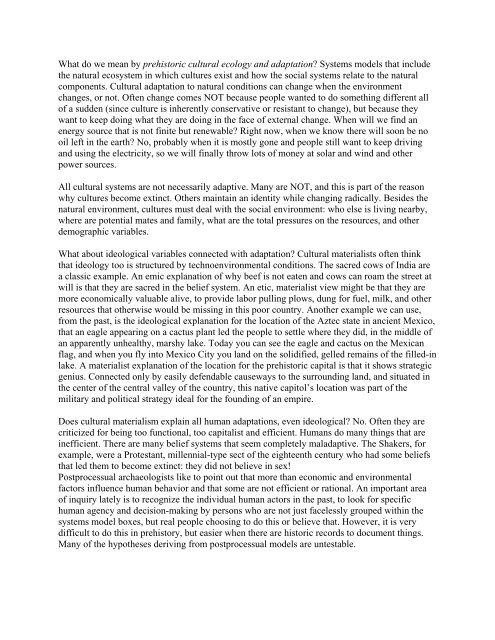INTRODUCTION TO ARCHAEOLOGY Nancy White - Touro Institute
INTRODUCTION TO ARCHAEOLOGY Nancy White - Touro Institute
INTRODUCTION TO ARCHAEOLOGY Nancy White - Touro Institute
Create successful ePaper yourself
Turn your PDF publications into a flip-book with our unique Google optimized e-Paper software.
What do we mean by prehistoric cultural ecology and adaptation? Systems models that include<br />
the natural ecosystem in which cultures exist and how the social systems relate to the natural<br />
components. Cultural adaptation to natural conditions can change when the environment<br />
changes, or not. Often change comes NOT because people wanted to do something different all<br />
of a sudden (since culture is inherently conservative or resistant to change), but because they<br />
want to keep doing what they are doing in the face of external change. When will we find an<br />
energy source that is not finite but renewable? Right now, when we know there will soon be no<br />
oil left in the earth? No, probably when it is mostly gone and people still want to keep driving<br />
and using the electricity, so we will finally throw lots of money at solar and wind and other<br />
power sources.<br />
All cultural systems are not necessarily adaptive. Many are NOT, and this is part of the reason<br />
why cultures become extinct. Others maintain an identity while changing radically. Besides the<br />
natural environment, cultures must deal with the social environment: who else is living nearby,<br />
where are potential mates and family, what are the total pressures on the resources, and other<br />
demographic variables.<br />
What about ideological variables connected with adaptation? Cultural materialists often think<br />
that ideology too is structured by technoenvironmental conditions. The sacred cows of India are<br />
a classic example. An emic explanation of why beef is not eaten and cows can roam the street at<br />
will is that they are sacred in the belief system. An etic, materialist view might be that they are<br />
more economically valuable alive, to provide labor pulling plows, dung for fuel, milk, and other<br />
resources that otherwise would be missing in this poor country. Another example we can use,<br />
from the past, is the ideological explanation for the location of the Aztec state in ancient Mexico,<br />
that an eagle appearing on a cactus plant led the people to settle where they did, in the middle of<br />
an apparently unhealthy, marshy lake. Today you can see the eagle and cactus on the Mexican<br />
flag, and when you fly into Mexico City you land on the solidified, gelled remains of the filled-in<br />
lake. A materialist explanation of the location for the prehistoric capital is that it shows strategic<br />
genius. Connected only by easily defendable causeways to the surrounding land, and situated in<br />
the center of the central valley of the country, this native capitol’s location was part of the<br />
military and political strategy ideal for the founding of an empire.<br />
Does cultural materialism explain all human adaptations, even ideological? No. Often they are<br />
criticized for being too functional, too capitalist and efficient. Humans do many things that are<br />
inefficient. There are many belief systems that seem completely maladaptive. The Shakers, for<br />
example, were a Protestant, millennial-type sect of the eighteenth century who had some beliefs<br />
that led them to become extinct: they did not believe in sex!<br />
Postprocessual archaeologists like to point out that more than economic and environmental<br />
factors influence human behavior and that some are not efficient or rational. An important area<br />
of inquiry lately is to recognize the individual human actors in the past, to look for specific<br />
human agency and decision-making by persons who are not just facelessly grouped within the<br />
systems model boxes, but real people choosing to do this or believe that. However, it is very<br />
difficult to do this in prehistory, but easier when there are historic records to document things.<br />
Many of the hypotheses deriving from postprocessual models are untestable.
















